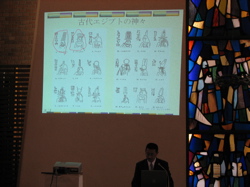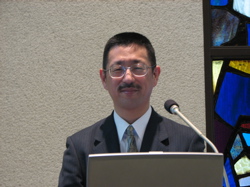Center for Interdisciplinary Study of Monotheistic Religions(CISMOR)Doshisha University
> Public Lectures > Gods of the Ancient EgyptiansPublic Lectures
Lecture (Open for the public)
Gods of the Ancient Egyptians
| Date: |
2007/03/17 14:00-16:00 |
|---|---|
| Place: | Chapel in the Divinity Hall, Imadegawa Campus, Doshisha Univ. |
| Lecture: | Hiroshi Suita (Professor, Faculty of Letters, Kansai University) |
| Summary: | |
|
In this lecture, which was held under the joint auspices of CISMOR and the Society for Near Eastern Studies in Japan, Professor Suita first introduced the work in Egyptian studies at Kansai University which is mainly preoccupied with collecting data and reading documents. The history of ancient Egypt began in 3.000 B.C. and lasted for 3000 years, and it is characterized by a unique polytheistic world-view. It was not polytheism against monotheism, but instead a very adaptable faith. According to the lecturer, there is a unique difficulty in ancient Egyptian studies. The documents of ancient Egyptian religion are piecemeal and connotative. That is, they depict particular rituals or scenes of the afterlife, but not the whole system of the religion. Taking for example a document of King Ramses I, it tells us at most the names of some gods, in this case Anubis or Horus, but not the whole context in which their names appear. However, the documents do make it possible for us to list the names of the gods. And the listing tells us that the ancient Egyptian gods appear under various names and figures, surpassing our understanding. For example, Horus has other names such as Hara, Haro, and Haru; the god Khepri has the head of an insect. Observing this diversity, we learn about the multivalent and seemingly ruleless way the ancient Egyptian gods are expressed as a feature of the religion. On the other hand, the aforementioned feature gives us a point of view from which to wonder whether these gods were actually deities for ancient Egyptians. Dr. Suita discussed the possibility of seeing these various and flexible figures as a clue to understanding the process of development toward Egyptian monotheism. For example, the religious documents mark the names of gods, as mentioned. But sometimes there is an honorific title put down with other proper names of deities, such as the expression 'great god' seen at the grave of Idout which the lecturer investigates. Since the names of gods are clearly referenced, such ambiguous expressions might bring discomfort to some. Dr. Suita offered a hypothesis that this expression covertly points to one true God whose name and figure are hidden, though this is difficult to prove. So, we are allowed the possibility of thinking that ancient Egyptians avoided giving one specific figure or name for their gods, and that this generated the variety and apparently ruleless manner in depicting the ancient Egyptian deities. The lecture introduced other research directions around this theme, such as a hypothesis that the change from polytheism to monotheism in ancient Egypt was due to a preoccupation with social crises. This theory is adaptable to the case of centralization by King Ikhnaton in an era of monotheism called Amarna during the New Kingdom. In this case, the monotheism is not a religious form set against polytheism, but a function in an emergent move to work around social crises in a polytheistic world. Kenichiro Takao (COE Research Assistant, Graduate Student of School of Theology, Doshisha University |
|

